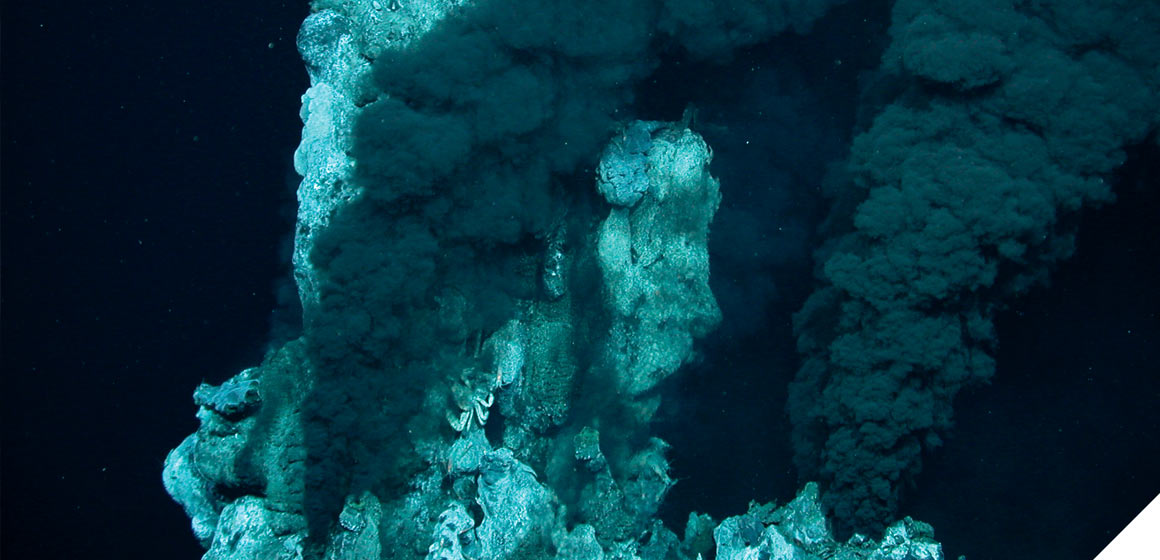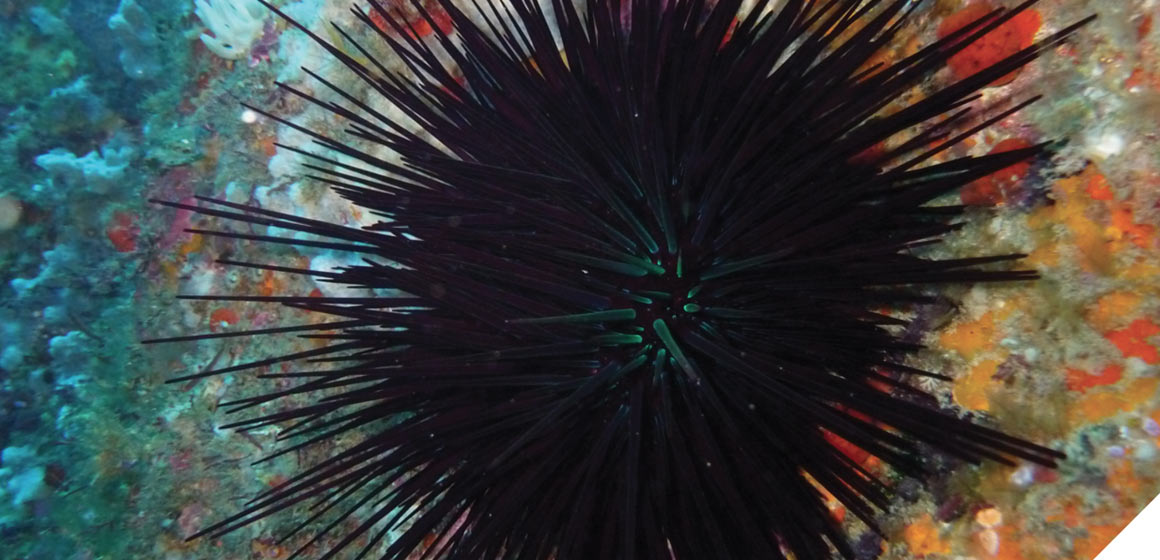From the largest to the very smallest sea creatures, and from estuaries to deep-water trenches, Otago researchers are striving to increase our understanding of the vast oceans that make our planet habitable.
The world‚'s oceans are crucial to life on earth. They supply water and food, drive the weather engine, influence the climate and act as a buffer to rapid change.
But we know relatively little about them, which is why ocean science is so important. It covers a vast range of topics and New Zealand is leading the world in many of them.
CO2 predictions
Dr Kim Currie (Chemistry and NIWA) has been measuring carbon dioxide levels and their effects off the coast of Otago for the past 15 years, aiming to develop better predictions of how the Southern Ocean might be able to absorb the greenhouse gas.
Global oceans currently soak up a quarter to a third of the carbon dioxide emitted to the atmosphere by human activities such as fossil fuel burning and deforestation.
This additional carbon dioxide can affect the ocean chemistry that supports marine life.
Currie's team monitors changes along a transect running out from Taiaroa Head to 65 kilometres offshore. They have found that carbon dioxide concentrations vary in the different water types along the transect: near-coastal, modified subtropical, and sub-Antarctic surface water. Concentrations are also affected seasonally by temperature changes and biological activity.
But overall, Otago's local waters are becoming more acidic, which fits with what is happening in other areas of the oceans and will have consequences for many marine organisms, particularly those that use calcium carbonate to build their shells.
Currie's research – one of very few long-term carbon dioxide studies worldwide and the only one in the Southern Hemisphere – adds to the global data needed to help address the effects of climate change.

A wealth of micro-organisms have adapted to the extreme conditions around deep-ocean hydrothermal vents.
Ocean "indigestion"
So what happens to sea life when oceans become more acidic? Associate Professor Abby Smith (Marine Science) says the effects are alarming.
"By burning fossil fuels, we have been increasing the carbon dioxide in the atmosphere for the last 200 years, effectively insulating and warming Earth.
"The resulting changes in climate have been reduced because of the amount of carbon dioxide in the air being absorbed by the oceans. But that is making the sea more acidic, which reduces the availability of carbonate ions used, along with calcium, to construct the shells of many marine plants and animals, including clams, snails, urchins, corals, some algae and many plankton."
Coccolithophores, which are tiny planktonic plants, are usually protected by a robust and complex ball of carbonate – but in more acid conditions, their shells are thinner and more frail.
"Think of it this way – every time you choose to walk or bike instead of burning fossil fuels, you are saving a planktonic plant that can continue to produce air for us to breathe."
Not only are these plankton the basis of the food chain, they produce almost half the oxygen in the atmosphere. Every other breath we take comes from the sea.
Ocean warming and acidification also mean that some corals won't make a skeleton, but sit there like a jelly glob – potentially meaning no more coral reefs in the future, for fish or tourists, says Smith.
The negative effects of acidic oceans could spread from tourism to fisheries and marine aquaculture, and even to shipping and ports that might have to tackle increased corrosion.
Early estimates suggested acidity could rise by 30 per cent by 2100. But more recent work indicates that we will be seeing significant – and irreversible – changes in the Southern Ocean within decades.
"There are no practical solutions or cures – no antacid for the sea's indigestion," says Smith. "The only thing we can do is to slow it down.
"Think of it this way – every time you choose to walk or bike instead of burning fossil fuels, you are saving a planktonic plant that can continue to produce air for us to breathe."
Methane potential
Dr Andrew Gorman (Geology) is investigating the seafloor for abundant and extraordinary accumulations of the natural gas methane, which is a potent greenhouse gas, but could also be of enormous economic benefit to New Zealand and the world.
Methane forms naturally from decaying organic material, which is common in seafloor sediment.
In the low-temperature, high-pressure world of the deep ocean, the gas naturally bonds with water to form an ice-like solid called methane hydrate, which has recently been discovered in spectacular deposits off the coast of New Zealand.
"Methane is a very powerful greenhouse gas, so it is important to understand the links between atmospheric methane and the gas hydrates found in the seafloor."
Seismic investigations on the continental slope of the Hikurangi Margin, south of the Wairarapa and east of Marlborough, indicate that the accumulation of gas hydrates here could be one of the world's largest.
Gorman and his team are researching the distribution and concentration of the deposits to understand the role of the hydrates in the world's carbon cycle and their influence on ancient – and current – climate.
"Methane is a very powerful greenhouse gas, so it is important to understand the links between atmospheric methane and the gas hydrates found in the seafloor," says Gorman.
The Otago team is part of an extensive New Zealand and international research effort that is also trying to assess the technical and environmental challenges of accessing these widely distributed, but low concentrations of hydrates as a producible hydrocarbon resource.
Tracing elements
Dr Rob Middag (Chemistry) doesn't see dust the way most people do. For Middag, it's not a household problem, but one of the bases of life in the sea.
Atmospheric dust is the main external supply of biological essential trace elements to the surface waters of the open oceans worldwide. The trace elements are critical for marine life. They influence the functioning of ocean ecosystems and the amount of atmospheric carbon they can absorb, which affects global climate.
Middag is part of the international GEOTRACES programme working on understanding the complex and wide-ranging marine biogeochemical cycles of trace elements and their isotopes on an unprecedented global scale.
A recent expedition from the Atlantic to the Mediterranean Sea assessed 11 different metals as well as isotopes of iron, zinc and cadmium. Isotope analysis is being carried out by collaborator Dr Claudine Stirling (Chemistry) who is also researching the role of the ocean in past climate change.
Due to the large amount of dust from the Sahara Desert, the Mediterranean Sea is an ideal natural laboratory to study the influence of atmospheric dust.
Iron and zinc play a crucial role in the growth of phytoplankton, the basis of primary production in the ocean, whereas the role of cadmium is still under debate.
The study aims to identify modern ocean processes that control the distributions of key trace elements and isotopes, and to establish how sensitive they are to changing environmental conditions.
Metal effects
Dr Sylvia Sander (Chemistry, and a director of the Research Centre for Oceanography) is also working with trace metals, from those found in fresh water and estuaries to deep-sea hydrothermal vents.
Many trace metals have a biological role in living organisms, such as in enzymes or metabolic functions. But there is an optimal concentration of these traces, or micronutrients. Too little is not enough and too much can be toxic.
"It is important to be able to estimate the bioavailable forms of trace metals for many reasons," says Sander. "For example, we may need to set limits for acceptable trace metal contamination in areas of intensive land use or, at the other end of the scale, understand where a trace metal may limit primary production."
She and her team are analysing accessible forms of trace metals, along with factors that influence them. The goal is to fit them into numerical models that will help predict bioavailable concentrations and improve understanding of how they affect living organisms.
Different species in different locations tolerate different levels of exposure to trace metals.
Sander's work on deep-ocean hydrothermal vents reveals a wealth of micro-organisms and marine animals that have adjusted perfectly to extremely high concentrations of trace metals and developed ways of surviving an environment that would be lethal for most creatures.

Yellow-eyed penguins and other seabirds concentrate recycled iron and nutrients in their droppings.
Nutrient dynamics
One of the trace elements that is in short supply in the Southern Ocean is iron. This limits the productivity of phytoplankton, which use it to form light-absorbing pigments. But the iron that is collected is passed up the food chain, making it available in reasonable concentrations to meet the metabolic needs of large oceanic creatures.
Associate Professor Stephen Wing (Marine Science) is studying how seabirds, such as albatross and penguins, collect iron and nutrients from around the vast Southern Ocean and then recycle them in their droppings.
Although they are ocean dwellers, they congregate in huge numbers around the sub-Antarctic islands to breed.
"Understanding the role of seabirds in nutrient dynamics around these islands is vital to our predictions of how biodiversity in the Southern Ocean will respond to stressors such as species introductions and commercial fishing, and to climate change."
This results in large amounts of soluble, bioavailable iron from guano being collected and delivered to these regions, which could greatly enhance productivity.
This productivity could be making a difference at the major hotspots of biodiversity in the Southern Ocean, which include breeding colonies for several endangered species besides the birds.
Wing and his team are using stable isotopes to track the flow and bioaccumulation of nutrients around the island systems to see if the seabird droppings are a significant factor in island productivity.
"Understanding the role of seabirds in nutrient dynamics around these islands is vital to our predictions of how biodiversity in the Southern Ocean will respond to stressors such as species introductions and commercial fishing, and to climate change."
Species invasion
Some species may gain from climate change and warming oceans.
Dr Miles Lamare (Marine Science) focuses on the physiology and biology of marine invertebrate species, especially their larval stages. For the past decade he has been examining their responses to climate change.
Recently, a warm, temperate sea urchin has expanded its southern range in Australia, with a detrimental effect on kelp communities it has been able to invade with higher sea temperatures. The species occurs in northern New Zealand, so is it likely that it might spread southwards?
Little is known about the factors influencing population distribution, so Lamare and his team are using genetic markers and population structures to model larval supply and recruitment patterns in New Zealand.
The case study should help address the wider question of how warmer sea temperatures might aid the spread of warm water species, which is particularly important when they are recognised as invasive and habitat-modifying.
We don't yet know what the implications will be for New Zealand marine ecosystems," says Lamare.
His wider research includes identifying adaptation and acclimation to temperature in species from polar, temperate and tropical regions, and from various thermal regimes.
 The sea urchin Centrostephanus rodgersii, which has expanded its southern range in Australia. Will it do the same in New Zealand?
The sea urchin Centrostephanus rodgersii, which has expanded its southern range in Australia. Will it do the same in New Zealand?
Human impacts
Humans have been responsible for far faster effects on species than climate change.
Professor Jon Waters (Zoology) has been investigating what happened to species like penguins and sea lions when humans arrived in New Zealand less than a thousand years ago.
It was the world's last major landmass to be colonised by humans and there are well-preserved archaeological records of extinctions of endemic animals soon afterwards.
In biology, ancient mass extinction events are thought to have paved the way for dramatic new evolutionary opportunities for surviving lineages. However, relatively little attention has been devoted to understanding the implications of recent human-mediated extinction events, such as those in New Zealand.
Waters' analysis of the DNA of ancient and current New Zealand sea lions and penguins shows that the earlier species were completely eliminated.
The modern species now populating our shores are genetically divergent sub-Antarctic lineages that colonised New Zealand relatively recently.
"The entire extinction-recolonisation episode has taken place over just a few centuries and the speed of the change highlights the potential for dynamic biological responses to anthropogenic influence," says Waters.
"The movement of small numbers of breeding individuals beyond the current range of a species can eventually lead to range expansion and replacement of extinct populations over human timeframes."
Marine mammal monitoring
Human activity is still threatening creatures around New Zealand today.
Professor Steve Dawson (Marine Science) and Associate Professor Liz Slooten (Zoology) have been using sound to predict the future of marine mammals in New Zealand waters. The University's Marine Mammal Research Group has been using echo-location loggers to find out how often the endangered Hector's dolphin use different parts of Akaroa Harbour throughout the year.
By logging their echo-location clicks, they found that the dolphins use the inner harbour not just in summer, but also often during winter, which is a time when gillnets are legally allowed to be used for fishing.
"The future for Hector's dolphin is bleak as long as nets that kill them are used in their habitat," says Dawson. "The rules need to change."
The nets can easily trap and drown the air-breathing dolphins.
"The future for Hector's dolphin is bleak as long as nets that kill them are used in their habitat," says Dawson. "The rules need to change."
The researchers have also used bottom-mounted sound recorders to learn when recovering populations of Southern
right whales visit their key breeding grounds in the Auckland Islands, how long they stay for, and how they are affected by noise from ships.
Ship noise has been shown to have clear impacts on communication in North Atlantic right whales.
Now, in collaboration with US colleagues, researchers are comparing the whales' sounds and their acoustic environments to see how these impacts occur and how New Zealand’s right whales might be affected as they start to return to mainland waters.
"These whales are slowly recovering to the mainland," says Slooten. "We hope that the noise caused by ships coming in and out of Otago Harbour will not deter the whales from re-establishing themselves here."
Funding
Dr Kim CurrieNIWA Core Funding
Associate Professor Abby Smith
University of Otago
Dr Andrew Gorman
Marsden Fund
Ministry of Business, Innovation and Employment: GHR Programme
Dr Rob Middag
Dutch Mediterranean GEOTRACES programme
Netherlands Organisation for Scientific Research (NWO), Division of Earth and Life Sciences (ALW)
University of Otago Research Grant
Dr Sylvia Sander
Marsden Fund
Ministry of Business, Innovation and Employment/NIWA
International Science and Technology international mobility funding
Associate Professor Stephen Wing
Marsden Fund
Antarctica New Zealand
University of Otago
Dr Miles Lamare
University of Otago
Australian National University, Canberra
Flinders University, Adelaide
Victoria University of Wellington
Professor Jon Waters
Marsden Fund
Allan Wilson Centre
Professor Steve Dawson and Associate Professor Liz Slooten
New Zealand Whale and Dolphin Trust
Foundation for Research, Science and Technology (now Ministry of Business, Innovation and Employment)
University of Otago
Otago Museum